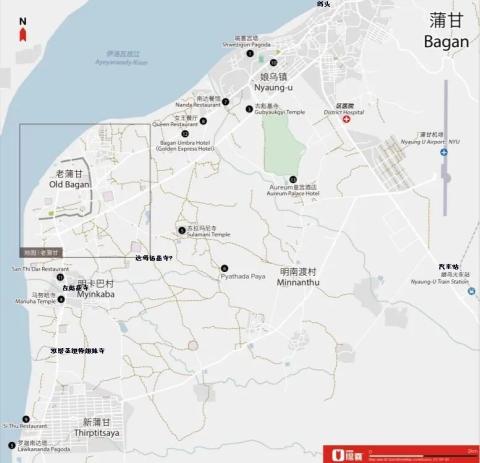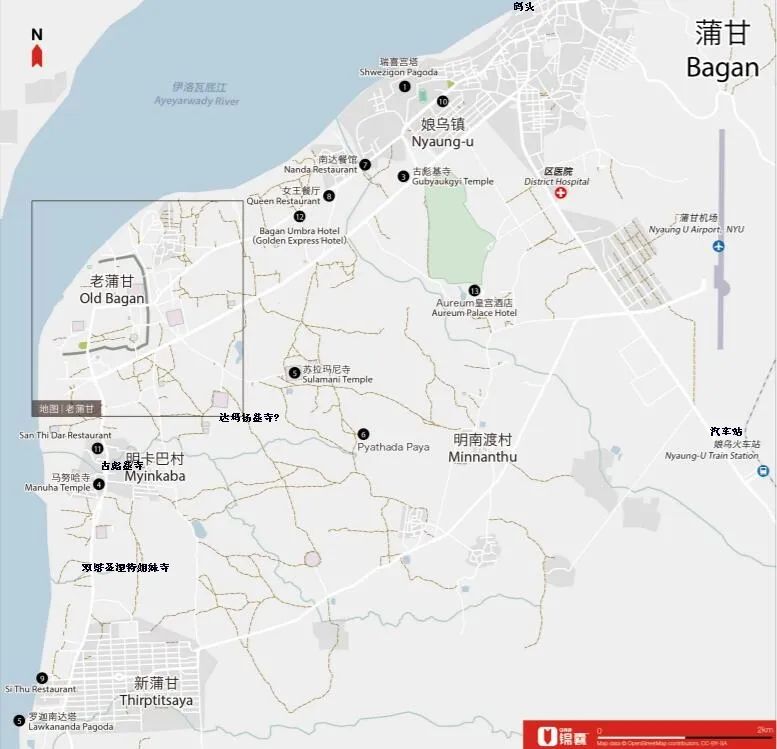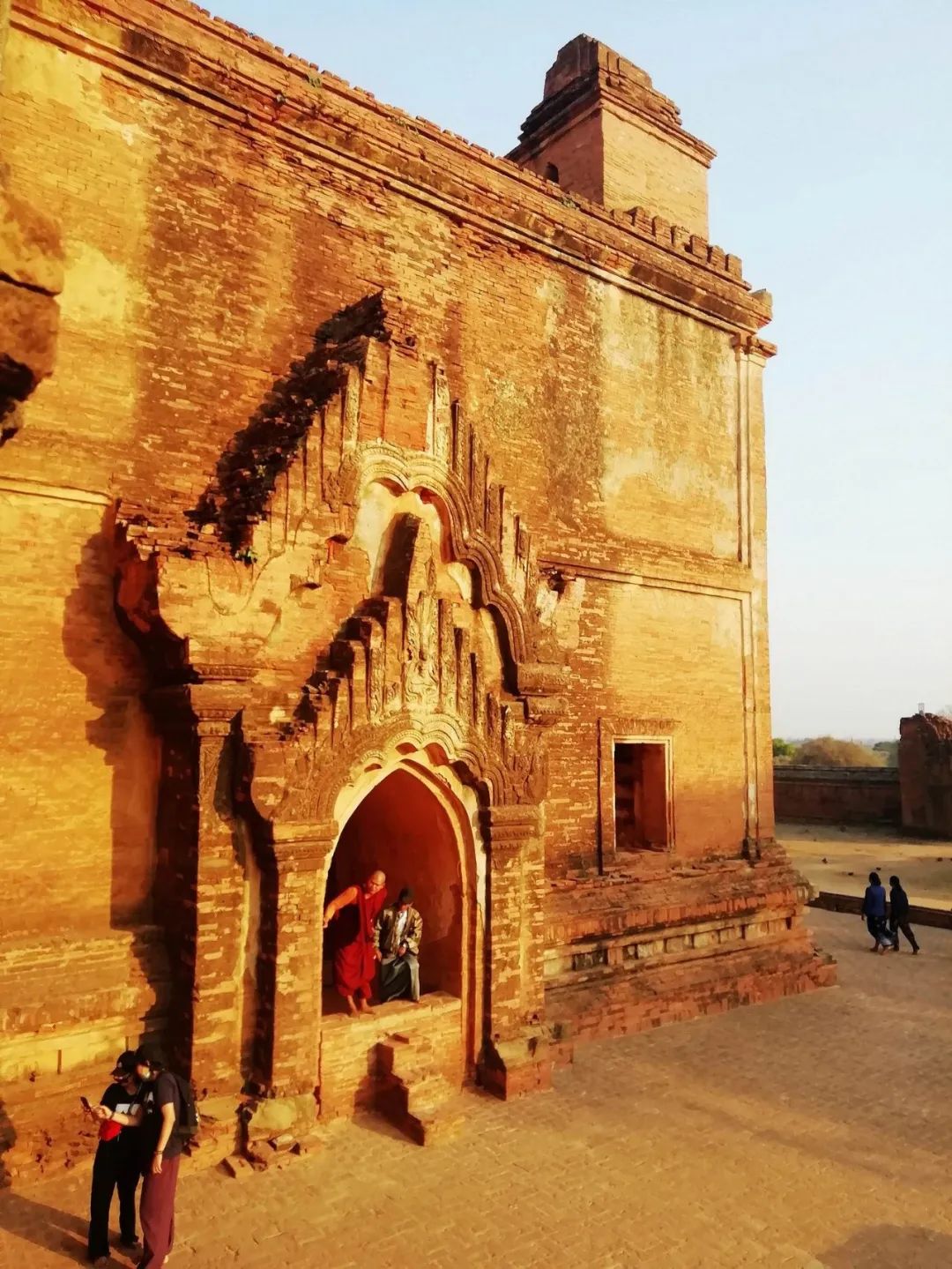
Bagan is an ancient historical city in Myanmar, a Buddhist cultural site, and a famous tourist attraction. It is located on the left bank of the middle reaches of the Irrawaddy River. At the beginning of the 2nd century AD, Bagan was a small town composed of 19 villages. It was called "Alimathanapura" in ancient times. In 849 AD, King Pinye built a city in Bagan, built 12 gates and dug a moat to surround it. In 1044, King Anawrahta founded the first unified Bagan dynasty in Myanmar history that included Burmese, Shan, Mon and other ethnic groups. Bagan became the capital of the dynasty. At that time, the king believed in Buddhism. When he conquered the Kingdom of Southern Burma, he received 32 Tripitaka scriptures, 300 eminent monks and many skilled craftsmen, so he began to build a large pagoda in Bagan. Over the next 200 years, the The number of pagodas is increasing, and Bagan is also known as the "City of Four Million Pagodas". However, due to subsequent changes in dynasties, capital relocation, wars, Western colonial invasions and earthquakes, there are only about 2,000 existing ruins left.
The ancient city of Bagan is the ultimate destination for travel in Myanmar and even Asia. It is one of the three major Buddhist relics in Southeast Asia. The more than 4.486 million pagodas and temples in the past gave it the reputation of "City of Ten Thousand Pagodas". "Every finger is a pagoda." This is the classic description of Bagan. The "finger" here refers to any location in Bagan. Bagan temples are divided into early period (AD 850-1120, built by the Mon people under the influence of Hindu Buddhist caves), middle period (AD 1120-1170, the pagoda has two floors), and late period (AD 1174-1300, the pagoda (more layers and larger scale), most of the pagodas we see now are late-stage pagodas. In the Bagan pagoda forest, there are four pagodas with Buddha's tooth, Shweishantha Pagoda, Shwe Saigon Pagoda, Danjidang Pagoda, Luo Gananda Pagoda and Guyindang Pagoda. 2019The ancient city of Bagan was included in the World Heritage List.
The Bagan scenic area is approximately a square. Old Bagan is in the upper left of the map, Nyaung-u is in the upper right, Myinkaba is in the middle on the left, Minnanthu is in the middle on the right, and the so-called New Bagan is in the lower left. Gan Thirptitsaya, and on the lower right is the village of Pwasaw. The main attractions are concentrated in Old Bagan and Nyaung U Town. Local residents mainly live in New Bagan, and Nyaung U Town is the transportation center and hotel center of Bagan. After I came to Bagan, I first stayed in Nyaung U Town, rented an electric motorcycle from the hotel owner, and started my Bagan trip.
Bagan Map (Quick Travel)

Old Town Map (Qionyou)

I first came to Lawkananda Pagoda, which is located on the Irrawaddy River. It was built in 1059 during the reign of King Arurudha. It is one of the burial places of Buddha's relics. The whole body of the pagoda is painted with gold paint, and its appearance looks like a clock.

The pagoda is on the bank of the Irrawaddy River


The Lawkananda Lake under the Luogananda Pagoda has a bit of an Indian pond flavor.

Cycling north, you can see the Ashe Petleik Pagoda


The twin-towered St. Nyet Ama Gu Phaya next to the road, one named St. Nyet Ama (sister) Sein Nyet Ama, and the other named St. Nyet Nyet Ama (sister) Sein Nyet Nyima, were built by Queen Seinyet. In the 11th century.

Among them, the sister temple has four steps on the upper floor. The lower three floors have small pagodas on the four corners, there are stairs on the inside, and the main pagoda spire is built on the top floor.


The spire of my sister's temple has been damaged.

Further north is the Nagayon Hpay Temple, which means snake sanctuary. It is located in the south of Mingaba Village. It was built by King Jiangxi Tuo in the 11th century. According to legend, the location of this temple was under the protection of the Naga snake god Jiangxi Tuo. A place to sleep. Therefore, there is a standing statue of Buddha twice the size of a real person enshrined in the temple, with a huge snake-shaped pattern behind it. The Buddha statues on both sides are half smaller. If you look carefully, you will find a snake tail behind the Buddha statue.




Not far to the north of Nagyong Temple is Manuha Temple, which was built in 1059 by King Manuha, a captive Mon king.

In the temple, there are three huge Buddha statues on the front and a 20-meter-long reclining Buddha on the back. What is not commensurate with the huge Buddha statue is that the temple housing the Buddha statue is very small, with a narrow space. His head almost reaches the eaves and his shoulders touch the wall. Manuha expressed his inner depression and pain by building such a narrow temple.




There is a huge golden bowl at the entrance of Manuha Temple, which contains donations from believers.


Further north is the Gubyaukgyi Temple, which contains 544 pictures of Buddha's life to praise the touching deeds of the Buddha's five hundred and fifty reincarnations.

Next to it is the Myazedi Pogada, which is also known as the "Emerald Pagoda". Legend has it that King Anawrahta ascended the throne after killing the previous king, his half-brother Sokkade, in a duel. As a sign of repentance, he built this tower in 1044 on the throne of the duel.


Continue walking east and you can see the towers.



Shwesandaw Pagoda was built by King Anuruddha in 1057. This pagoda houses the hair relics of the Buddha. The entire pagoda rises in the shape of a pyramid, with a square base and five floors. On the fifth floor is a huge platform, and the white pagoda on top begins to take on a bell shape.


A 20-meter-long reclining Buddha can be seen in a rectangular Buddhist temple next to the Shweishantho Pagoda.

Then I went to Damayangji Temple

Dhammayangyi Temple was built by King Narathu (1163-1165). It is the most majestic pagoda in Bagan. The brick-red pagoda can be seen from anywhere in Bagan. It is the representative of brick pagodas. . Since the king was assassinated before it was completed, the top of the tower has not yet been built, and the locals also call it the Tower of Doom.






It was already sunset, and I saw a large dirt slope nearby. There were many cars parked under the slope. This is the place to watch the sunset in Bagan. When I walked up the slope, someone actually checked the tickets. Fortunately, I checked in at the hotel. Bought a ticket.

Although it is a sunny day today, the whole sky is gray. The sun sets between the towers. I don't feel the shock, but I feel a sense of desolation. Do you think that the ancient country of Bagan disappeared silently like this?




I got up before dawn the next day and continued driving to the spot where I watched the sunset yesterday to watch the sunrise.

While it was dark, I climbed up a small tower and waited for the sun to rise.

But he was soon kicked off by the scenic spot staff.


The sun finally showed its face

I feel that the more spectacular scenery here is not the Thousand Pagodas, but the hot air balloon above the towers. It is said that a balloon ride to watch the sunrise costs 500 US dollars.





After watching the sunrise, I continued my pagoda tour in Bagan and first came to Thatbinnyu Pahto. This temple was built by King Alaungsithu in the 12th century. It is the tallest pagoda in Bagan, with a height of 67 meters and a total of The 7-story pagoda, the facade of the building consists of two huge overlapping three-dimensional squares. Appearance is white.



internal


200 meters north of Dabinyu Temple is the Shwegugyi Temple built by King Alaungsithu in 1311. It is built on a high platform and has very exquisite reliefs inside.



Back on the road, I met a group celebrating the children's ordination. I saw a boy who became a monk, dressed like a prince, riding a horse and following a float. The cows were also tied with colorful ribbons, and the women were holding flowers. There are also clown shows, like a parade.







Then walking east, you can see Ananda-okkyaung Monastery, which retains very exquisite murals.








Not far from the monastery is Ananda Temple, which was built by King Kyansittha in 1091 and is known as the first pagoda in Bagan. The entire temple is square, with a courtyard on the outside and the Ananda Pagoda in the middle. In the four corners of the tower, there is a statue of a mythical beast with a head and two bodies.




There is a square corridor inside the pagoda, densely inlaid with golden Buddha statues. In the four directions of the pagoda, there is a standing golden Buddha about ten meters high. Each one has a different posture and represents a different meaning.





Then I drove to Sulamani Temple. This temple was built by King Narapatisithu in 1183. According to historical records, when Narapatisithu came to the throne, he saw a ruby shining in the depression and thought it was an instruction from the Buddha, so he built it here. The Sulamani Temple was built. Sulamani Temple is a two-story platform building with square platforms, and small stupas are built at the corners of each platform to symbolize sacred objects and show admiration. There are four porches in the whole pagoda temple, the one facing east is the largest. Each door of the pagoda is decorated with a small semi-relief pagoda and door lintel, and a large number of flames and triangular shapes are also used on the door pillars.



Sulamani Temple also has a square cloister, which is famous for retaining a large number of murals. There are ancient murals left on the internal walls, which involve the hierarchy, clothing, national customs and social activities of ancient Myanmar. You can still see brightly colored murals today. color. Some people call it the most beautiful pagoda in Bagan.





Continuing driving, I came to Mahabodhi Temple, which was built in 1215 by King Htilominlo and is the only Indian-style building in Bagan. It was built in imitation of the Mahabodhi Temple in Bodh Gaya, India. It is centered on the triangular main tower and is divided into seven floors, representing the seven weeks of Buddha's enlightenment. It is surrounded by small auxiliary towers. The tower base is surrounded by three-story stone Buddha statues. The tower body is pyramid-shaped and filled with concave Buddhist niches, which contain Buddha statues of various shapes.


internal



Going further north, you will come to the east bank of the Irrawaddy River. There is a Bupaya Pagoda here. The pagoda is in the shape of a gourd. It stands golden and golden on the bank of the Irrawaddy River. There is no obstruction around it. It is a good place to watch the sunset.


Continue riding towards Nyaung U Town. There are pagodas everywhere on the roadside. This is the Upali Thein. It is a rectangular pagoda built in the 13th century. Upali was a famous monk. The roof is decorated with crenellated roofs and roofs. The rising central minaret imitates Burmese wooden structures.

2101 Tower


I can’t remember the names of many pagodas. If you just point your finger here in Bagan, it is the pagoda.










Shwezigon Pagoda is the oldest temple in Bagan and the only stone building in Bagan. It is one of the four most sacred pagodas in Myanmar along with the Shwezigon Pagoda. The construction of this pagoda went through the periods of two kings Anawrahta (1044-1077) and Kyansittha (1084-1113). It is the founding pagoda of the Bagan Dynasty, the source of Burmese pagodas, and a typical example of early architecture. represent.

Temples and corridors around the tower






U Yan We Hpawa Pagoda northeast of Ruixi Palace Pagoda.

In the evening, I came to the Irrawaddy River again and enjoyed the sunset again.



This day and a half trip to Bagan Thousand Pagodas ended successfully.
